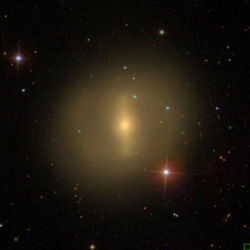Astronomy:NGC 4665
| NGC 4665 | |
|---|---|
 NGC 4665 by SDSS | |
| Observation data (J2000 epoch) | |
| Constellation | Virgo |
| Right ascension | 12h 45m 06s[1] |
| Declination | +03° 03′ 21″[1] |
| Redshift | 0.003042 ± 0.000017 [1] |
| Helio radial velocity | 912 ± 5 km/s[1] |
| Distance | 58 Mly (17.9 Mpc)[2] |
| Apparent magnitude (V) | 10.3 [3] |
| Characteristics | |
| Type | SB(s)0/a [1] |
| Apparent size (V) | 3.8′ × 3.2′ |
| Other designations | |
| NGC 4624, NGC 4664, UGC 7924, CGCG 043-018, MCG +01-33-005, PGC 42970[1] | |
NGC 4665, also catalogued as NGC 4624 and NGC 4664, is a barred lenticular or spiral galaxy located in the constellation Virgo. It is a member of the Virgo II Groups, a series of galaxies and galaxy clusters strung out from the southern edge of the Virgo Supercluster.[4] It is located at a distance of circa 60 million light years from Earth, which, given its apparent dimensions, means that NGC 4665 is about 75,000 light years across. NGC 4665 lies 2 and 3/4 degrees east-south east of Delta Virginis and 50 arcminutes southwest of 35 Virginis. It can be viewed through a moderately sized telescope with 23x magnification, forming a pair with an 11th magnitude star 1.5 arcminutes southwest. It is part of the Herschel 400 Catalogue.[5]
Observation history
It was discovered by William Herschel on February 23, 1784, however, he noted a location 10 arcminutes off the galaxy, where there is no object. It was observed by William Herschel again on April 30, 1786, noting the correct coordinates, and he misidentified it as another nebula. The fact that they are the same object was noted by John Louis Emil Dreyer in 1912 in the corrections of the New General Catalogue. It was also recorded independently on April 9, 1828 by John Herschel.[6]
Physical characteristics
NGC 4665 has a luminous, slightly elliptical bulge and a prominent bar with high surface brightness.[7] The isophotes appear boxy at the end of the bar.[8][9] The total bar length is estimated to be near 3 kpc.[10] The bar is slightly twisted, turning near 12 degrees along its axis.[11] Two diffuse, faint arms emerge from each side of the bar and form a pseudoring.[7] The surface brightness of the arms is higher near the bar.[12][13] The southern arm appears a bit stronger. An arch feature is observed at the east side of the galaxy that could be a partial outer dusty ring.[11] The outer isophotes are elliptical.[7] The total mass of molecular gas is less than 107.3 M☉.[14]
NGC 4665 belongs to the NGC 4636 group. Other members of the group include NGC 4457, NGC 4586, NGC 4587, NGC 4600, NGC 4636, and NGC 4688.[15] These galaxies, along with NGC 4753, Messier 61 and their groups form the southern boundary of the Virgo cluster. It can be difficult to determine which galaxies belong to which group, especially around the southern edge of the Virgo cluster where there is a confusion of galaxies at different distances.[16]
References
- ↑ 1.0 1.1 1.2 1.3 1.4 1.5 "NASA/IPAC Extragalactic Database". Results for NGC 4665. http://ned.ipac.caltech.edu/cgi-bin/nph-objsearch?objname=NGC+4665.
- ↑ Tully, R. Brent (1988). Nearby galaxies catalog. Bibcode: 1988ngc..book.....T.
- ↑ "Revised NGC Data for NGC 4665". http://spider.seds.org/ngc/revngcic.cgi?NGC4665.
- ↑ "The Virgo III Groups". Atlas of the Universe. http://www.atlasoftheuniverse.com/galgrps/viriii.html.
- ↑ O'Meara, Steve (2007) (in en). Herschel 400 Observing Guide. Cambridge University Press. p. 149. ISBN 9780521858939. https://books.google.com/books?id=Nyh9fAC_tpIC&pg=PA149.
- ↑ Seligman, Courtney. "NGC 4665 (= NGC 4624 = NGC 4664 = PGC 42970)". https://cseligman.com/text/atlas/ngc46a.htm#4665.
- ↑ 7.0 7.1 7.2 Eskridge, Paul B.; Frogel, Jay A.; Pogge, Richard W.; Quillen, Alice C.; Berlind, Andreas A.; Davies, Roger L.; DePoy, D. L.; Gilbert, Karoline M. et al. (November 2002). "Near-Infrared and Optical Morphology of Spiral Galaxies". The Astrophysical Journal Supplement Series 143 (1): 73–111. doi:10.1086/342340. Bibcode: 2002ApJS..143...73E.
- ↑ Ohta, Kouji; Hamabe, Masaru; Wakamatsu, Ken-Ichi (July 1990). "Surface photometry of barred spiral galaxies". The Astrophysical Journal 357: 71. doi:10.1086/168892. Bibcode: 1990ApJ...357...71O.
- ↑ Patsis, P. A.; Skokos, C.; Athanassoula, E. (11 June 2003). "Orbital dynamics of three-dimensional bars - IV. Boxy isophotes in face-on views". Monthly Notices of the Royal Astronomical Society 342 (1): 69–78. doi:10.1046/j.1365-8711.2003.06511.x. Bibcode: 2003MNRAS.342...69P.
- ↑ Gadotti, D. A.; de Souza, R. E. (April 2006). "On the Lengths, Colors, and Ages of 18 Face-on Bars". The Astrophysical Journal Supplement Series 163 (2): 270–281. doi:10.1086/500175. Bibcode: 2006ApJS..163..270G.
- ↑ 11.0 11.1 Erwin, Peter; Sparke, Linda S. (June 2003). "An Imaging Survey of Early-Type Barred Galaxies". The Astrophysical Journal Supplement Series 146 (2): 299–352. doi:10.1086/367885. Bibcode: 2003ApJS..146..299E.
- ↑ Kalapotharakos, C.; Patsis, P. A.; Grosbøl, P. (21 March 2010). "NGC 1300 dynamics - I. The gravitational potential as a tool for detailed stellar dynamics". Monthly Notices of the Royal Astronomical Society 403 (1): 83–95. doi:10.1111/j.1365-2966.2009.16127.x. Bibcode: 2010MNRAS.403...83K.
- ↑ Alexei Gadotti, Dimitri (February 2008). "Image decomposition of barred galaxies and AGN hosts". Monthly Notices of the Royal Astronomical Society 384 (1): 420–439. doi:10.1111/j.1365-2966.2007.12723.x. Bibcode: 2008MNRAS.384..420G.
- ↑ Young, Lisa M.; Bureau, Martin; Davis, Timothy A.; Combes, Francoise; McDermid, Richard M.; Alatalo, Katherine; Blitz, Leo; Bois, Maxime et al. (21 June 2011). "The ATLAS3D project - IV. The molecular gas content of early-type galaxies". Monthly Notices of the Royal Astronomical Society 414 (2): 940–967. doi:10.1111/j.1365-2966.2011.18561.x. Bibcode: 2011MNRAS.414..940Y.
- ↑ Makarov, Dmitry; Karachentsev, Igor (21 April 2011). "Galaxy groups and clouds in the local (z~ 0.01) Universe". Monthly Notices of the Royal Astronomical Society 412 (4): 2498–2520. doi:10.1111/j.1365-2966.2010.18071.x. Bibcode: 2011MNRAS.412.2498M. http://www.sao.ru/hq/dim/groups/galaxies.dat. Retrieved 8 January 2019.
- ↑ "The Virgo II Groups". http://www.atlasoftheuniverse.com/galgrps/virii.html.
External links
- NGC 4665 on WikiSky: DSS2, SDSS, GALEX, IRAS, Hydrogen α, X-Ray, Astrophoto, Sky Map, Articles and images
- NGC 4665 on SIMBAD
 |

